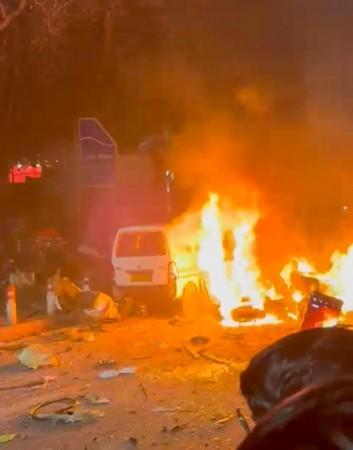
The initial investigation into the car explosion near Delhi's Red Fort Metro Station has hinted that this could be a suicide attack to cause maximum damage, said sources on Tuesday.
The blast occurred on Monday evening when a Haryana-registered car, a Hyundai i20, parked near Gate No.1 of the Red Fort Metro Station exploded, killing at least eight people and injuring dozens. High alerts have been issued in Delhi, Uttar Pradesh, Bihar, and Mumbai, with security around crowded public places and religious sites enhanced.
Initial investigations suggest the suspect's motive was to carry out the blast. As soon as he learned that the Faridabad module had been busted, he planned a suicide attack to cause maximum damage and avoid being caught by the police, sources said.
Currently, the agencies are working on every theory and trying to determine the motive behind the blast.
This incident came just hours after police busted a terror module linked to Jaish-e-Mohammad (JeM) and Ansar Ghazwat-ul-Hind terror outfits in Faridabad and seized 2,900 kg of explosives and a huge cache of arms and ammunition.

Police also announced that over the past few days, they have arrested two Jammu and Kashmir doctors, Adil Ahmad Rather and Muzammil, who were linked to these terror outfits, which, according to the sources, panicked the module and led to the blast.
Officials said that nothing is being ruled out at the moment, while adding that all angles point towards an act of terror. Sources said that the car in question was purchased by one Tariq, a resident of Pulwama, Jammu and Kashmir. His links to the Faridabad module are under investigation, the police added.
The police said that the car blew up at around 6.52 p.m. This triggered a fire that engulfed the vehicles that were nearby. Officials said that investigations point towards the involvement of the Faridabad module.
This module is suspected to have played a major role in supplying the explosives and also planning the attack. The police also suspect that one Dr Umar Mohammad, who was part of the Faridabad module, was present in the car at the time of the explosion.
A DNA test would help the investigators ascertain who was present in the car at the time of the blast. The agencies have been on the trail of Mohammad for several days now. He had been on the run, and the police say that he was clearly linked to the Faridabad module. Mohammad was an active member of the module and was involved in terror funding and the smuggling of arms and ammunition.
The trail of ownership is also crucial to the probe. Investigations have found that the car was first registered in the name of Mohammad Salman. He then sold it one Nadeem, who then handed over the vehicle to a car dealer in Faridabad. The car was then sold to Tariq before it finally landed up in the hands of Dr Umar Mohammad. Tariq is currently being questioned by the police.
It is, however, unclear if the car was meant to explode when it was parked or if the attackers drove it out in panic after the Faridabad module was busted.
However, an official part of the probe agency said that all angles currently suggest that it was a Fidayeen (suicide) attack. The sources added that the attack was carried out in haste and may not have gone as per the intended plan.

















